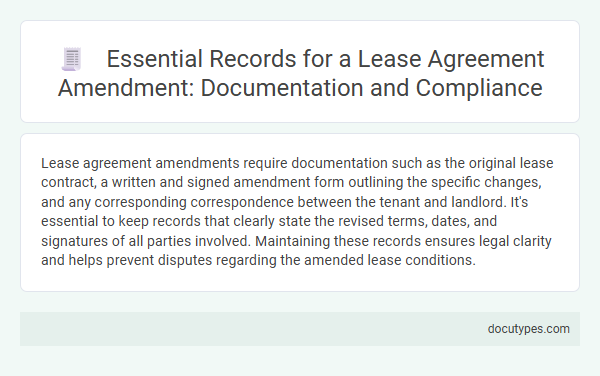Lease agreement amendments require documentation such as the original lease contract, a written and signed amendment form outlining the specific changes, and any corresponding correspondence between the tenant and landlord. It's essential to keep records that clearly state the revised terms, dates, and signatures of all parties involved. Maintaining these records ensures legal clarity and helps prevent disputes regarding the amended lease conditions.
Importance of Proper Documentation in Lease Amendments
Proper documentation is essential when making amendments to a lease agreement. Ensuring all records are accurate protects both parties and maintains clear terms.
- Original Lease Agreement - Provides the baseline terms and conditions that the amendment will modify.
- Amendment Document - Clearly outlines the specific changes agreed upon to avoid future disputes.
- Signatures of Both Parties - Validates the amendment as a legally binding modification to Your lease.
Core Elements of a Lease Agreement Amendment
A Lease Agreement Amendment requires essential records such as the original lease document, a detailed description of the changes being made, and the signatures of all involved parties. Core elements include clear identification of the property, specific clauses being modified, and the effective date of the amendment. Maintaining these records ensures legal validity and helps prevent disputes between landlords and tenants.
Required Identification and Contact Information
Records needed for a lease agreement amendment include valid identification and current contact information of all parties involved. Your government-issued ID, such as a driver's license or passport, verifies identity to prevent fraudulent changes. Accurate phone numbers, email addresses, and physical addresses ensure reliable communication throughout the amendment process.
Original Lease Reference and Cross-Referencing
When amending a lease agreement, the original lease reference is essential for clarity and legal accuracy. This reference includes the initial lease date, parties involved, and lease terms to ensure consistency.
Cross-referencing the original lease in the amendment helps maintain a clear connection between documents, avoiding confusion or disputes. This process involves listing the original lease details and specifying the sections being amended. Your amendment should precisely identify these elements to preserve the lease's integrity and enforceability.
Amendment Terms and Conditions
Amendment terms and conditions define the specific changes made to the original lease agreement, including rent adjustments, lease duration, and tenant obligations. Clear documentation ensures both parties understand their rights and responsibilities under the amended contract.
You must provide detailed records such as the original lease, the written amendment document, and any correspondence related to the changes. Maintaining these records helps prevent future disputes and supports legal enforcement if necessary.
Signatures and Witnesses: Ensuring Legal Validity
Signatures and witnesses play a crucial role in validating a lease agreement amendment. Ensuring these elements are properly documented protects Your rights and upholds the legal enforceability of the contract.
- Signatures of All Parties - Every party involved in the lease amendment must provide handwritten or electronic signatures to confirm mutual consent.
- Witness Attestation - A neutral witness should observe the signing to verify the authenticity of the signatures and the voluntary nature of the agreement.
- Notarization - In some jurisdictions, notarizing the amendment further ensures the document's legal validity and can prevent future disputes.
Notarization and Official Certification
Records needed for a lease agreement amendment include the original lease document and a detailed amendment outlining the changes. Notarization is crucial to authenticate the signatures and ensure the amendment's legal validity.
Official certification may be required depending on jurisdiction, providing an added layer of verification by a government authority. This process helps prevent disputes and confirms the amendment complies with local laws.
Supporting Evidence and Attachments
Supporting evidence and attachments are essential for a lease agreement amendment to ensure clarity and legal validity. Proper documentation helps verify changes and prevents disputes.
- Original Lease Agreement - The unaltered lease document serves as the baseline reference for all amendments.
- Amendment Form - A clearly signed and dated amendment form outlines the specific changes agreed upon by all parties.
- Supporting Correspondence - Any emails, letters, or notices relevant to the amendment provide additional context and confirmation of consent.
Maintaining organized records supports the enforceability and transparency of Your lease modification.
Record Keeping and Compliance Requirements
| Record Type | Description | Compliance Requirement | Retention Period |
|---|---|---|---|
| Original Lease Agreement | The initial contract outlining terms between landlord and tenant | Must be retained for legal verification and reference during amendment processes | Typically 7 years or as per local jurisdiction |
| Lease Amendment Document | Formal written changes or additions to the original lease agreement | Required for enforceability and evidencing agreed changes | Same as original lease agreement or longer if specified in local law |
| Correspondence Records | Emails, letters, or communication related to negotiation and agreement of amendments | Important for dispute resolution and compliance audits | Recommended 3 to 7 years based on regulatory standards |
| Signatory Identification | Copies of ID or verification documents of parties signing the amendment | Ensures authenticity and prevents fraud | Duration consistent with amendment records retention |
| Payment and Rent Records | Documentation showing rental payments reflecting amended terms | Necessary for financial audits and compliance with tax regulations | Often 7 years as per tax authority guidelines |
| Compliance Checklists | Lists confirming all legal and regulatory conditions are met for amendments | Supports adherence to landlord-tenant laws and local regulations | Retain until statute of limitations expires or longer if required |
What Records Are Needed for a Lease Agreement Amendment? Infographic

